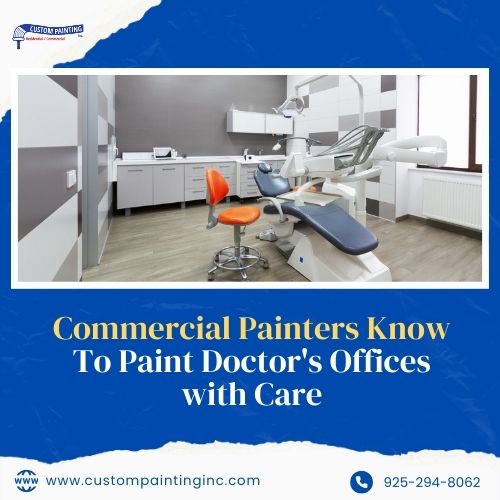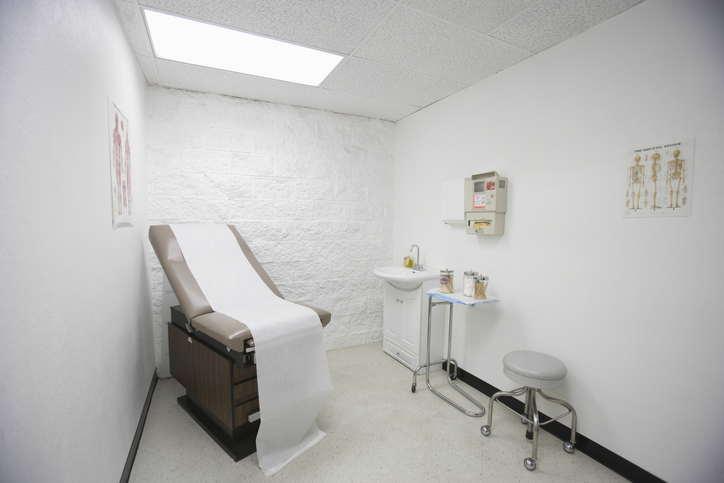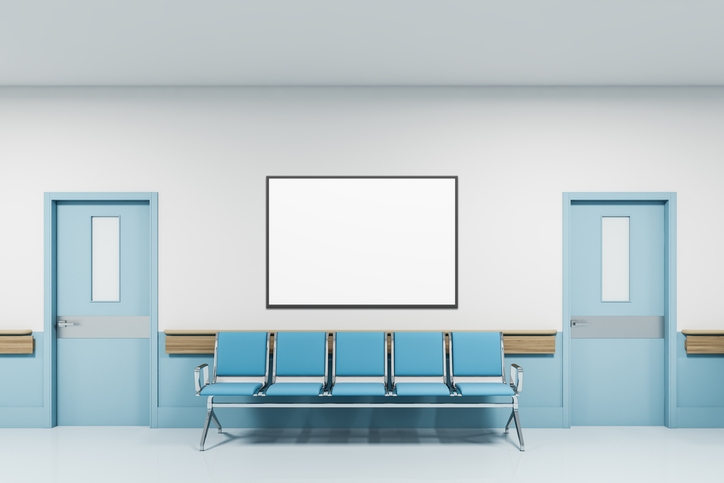Does the doctor’s office need a new look? The priority here is not to reflect your personal style but to create a comfortable and professional look that is also welcoming and calming for patients and their loved ones. Commercial painters know this, so they carefully consider this painting project. They also take certain measures to ensure the employees’ and patients’ health and safety. Upgrade your office environment affordably—see how our cabinet painting pros deliver seamless, durable results.
When painting a doctor’s office, commercial painters advise you on these tips:
1. Choose calming colors
In doctor’s offices, you must create a calming and comfortable environment for patients, so your choice of colors is crucial. Colors can largely influence mood and perception, which is why it’s essential to choose colors that promote relaxation and ease. Here are great color options for painting doctor’s offices:
- Light blue is an excellent choice for medical settings. This color is widely associated with tranquility and peace, making it perfect for reducing anxiety and creating a peaceful atmosphere. When patients enter a room painted in light blue, they will likely feel calmer and more relaxed. This can be perfect for waiting areas and treatment rooms where people are usually nervous and anxious.
- Green is another color that works wonders in a doctor’s office. It represents nature and has a soothing effect on the mind. Green can help reduce stress and promote a sense of balance and calm, making it ideal for areas where patients spend a lot of time, such as waiting rooms and consultation rooms.
- Neutral colors like white, beige, tan, and gray are also highly recommended. These colors create a clean and organized look, which can help in making the space feel professional yet welcoming. Neutrals are versatile and can complement various types of furniture and décor, making it easier to maintain a cohesive aesthetic throughout the office.
2. Avoid negative colors
When choosing paint colors for a doctor’s office, it’s just as important to know which colors to avoid as it is to know which ones to choose. Certain colors can negatively impact the atmosphere of the space and, in turn, affect the mood and comfort of your patients. Here are some color tips to remember:
- Avoid stark white. While white can symbolize cleanliness, stark white walls can often feel too clinical and cold. This can create an unwelcoming and sterile environment that may increase patient anxiety rather than alleviate it. Instead, opt for softer, warmer whites or other neutrals that still convey cleanliness but with a more inviting feel.
- Steer clear of bright or striking colors: Bold colors like bright red, orange, or neon shades can be overwhelming and can actually increase stress levels. These colors are too stimulating for a setting where calm and relaxation are essential. Bright colors can also distract patients and make the environment feel chaotic.
- Be cautious with dark colors: While some can be used effectively in small doses, using them extensively can make the space feel smaller and more closed in, which can be particularly unwelcoming in a medical setting. Dark colors can also absorb more light, making the room feel dim and less inviting.
- Don’t use orange-based hues: Colors with orange solid undertones can appear sickly and dirty over time, detracting from the clean, professional look you want in a doctor’s office. They can also evoke a sense of discomfort and unease, which is counterproductive to the calming environment you’re trying to create.
3. Consider the elements in the room
When selecting paint colors for a doctor’s office, it’s crucial to consider the existing elements in each room. This ensures a cohesive look and a harmonious environment that feels welcoming and well-thought-out.
Look at the furniture, artwork, and any architectural features remaining in the room. The paint color should complement these elements rather than clash with them. For instance, if your waiting room has dark wood furniture, a light, neutral wall color can create a balanced and inviting space.
Pay attention to permanent fixtures like flooring, countertops, and built-in cabinetry. These elements can greatly influence the color palette. For example, if you have gray tiles on the floor, choosing a complementary wall color like soft green or beige can create a cohesive look.
4. Involve staff and patients
Your staff spends significant time in the office, and their comfort is crucial for maintaining a positive work environment. Ask for their opinions on color choices. They can provide valuable insights into which colors might make their workspaces more pleasant and conducive to productivity.
Also, you can survey your patients. Patients’ comfort should be a top priority, and their opinions can provide a different perspective. Consider conducting a simple survey to gather their preferences on color schemes. This could be done through a suggestion box in the waiting area or an online survey sent via email.
5. Focus on durability
Investing in high-quality paint may be more expensive upfront, but it pays off in the long run. High-quality paints tend to have better coverage, are more resistant to wear and tear, and last longer than cheaper alternatives. This means fewer touch-ups and repaints, saving you time and money in the long term.
6. Consider washability and stain resistance
In a medical setting, cleanliness is paramount. Choose paints that are specifically designed to be washable and can withstand frequent cleaning without degrading. These paints are formulated to resist stains and can be scrubbed without losing color or finish, ensuring your walls remain pristine and hygienic.
Because of this, choose paints that have stain-resistant properties. This is particularly important in areas like exam rooms and labs, where spills and stains are more likely to occur. Stain-resistant paints prevent substances from penetrating the surface, making it easier to wipe them away without leaving a mark.
7. Create a uniform look
Keep it looking uniform to create a cohesive, professional, and calming environment. To do this, start by selecting a consistent color palette that can be used throughout the office. This doesn’t mean every room has to be the same color, but rather that the colors should complement each other and create a seamless flow from one area to the next. For example, using varying shades of blue and green can tie different rooms together while still allowing for some variation,
Choose accent colors that complement the primary color palette and use them strategically throughout the office. This can include accent walls, trim, and decorative elements. Also, keep your decorative elements uniform. For instance, if you choose modern furniture with clean lines and minimalistic decor, ensure that this style is carried through from the waiting area to the examination rooms.
8. Pay attention to finish
Choosing the right paint finish for your doctor’s office is as essential as selecting the right color. The finish affects the paint’s durability, cleanability, and overall appearance. Here’s how to pick the best finishes for different areas of your medical office:
- Matte finish: Also known as flat finish, this finish has a non-reflective surface that hides imperfections but is harder to clean. It is not ideal for high-traffic areas but can be used on ceilings or low-traffic walls.
- Eggshell finish: Slightly more reflective than matte, the eggshell finish is easier to clean and offers a bit more durability. It’s a good option for areas that see moderate use, such as offices and patient rooms.
- Satin finish: Satin finishes have a soft sheen and are more durable and easier to clean than an eggshell finish. They’re ideal for high-traffic areas like hallways, waiting rooms, and exam rooms. This finish strikes a balance between aesthetics and practicality, providing a pleasing look while being resistant to wear and tear.
- Semi-gloss finish: Highly durable and easy to clean, semi-gloss is perfect for areas that need frequent cleaning, such as bathrooms, kitchens, and any area where hygiene is a priority. Its shiny surface can reflect light, making spaces feel brighter and more spacious.
- Gloss finish: The most reflective and durable finish, gloss finish is often used for doors, trim, and cabinetry. While it’s the easiest to clean, it also shows imperfections more clearly, so it’s best used in areas that need to withstand a lot of wear.
9. Get professional help
While choosing the right paint, colors, and finishes is crucial, the application process is equally important. For a flawless, professional look that stands the test of time, consider hiring experienced painters specializing in commercial and medical settings.
At Custom Painting, Inc., we specialize in commercial painting services tailored to the unique needs of medical facilities. Our team of experienced painters is committed to delivering exceptional results that meet the highest quality and safety standards. We understand the importance of creating a welcoming and hygienic environment for your patients and staff. Serving the Bay area including the cities of Moraga, Mountain View, Orinda, Pleasant Hill and San Jose.
Let us help you choose the perfect colors and finishes to create a calming, welcoming, and professional atmosphere. Contact us through our website or give us a call at 925-294-8062 to get started. Trust us to bring your vision to life with our expert painting services.



